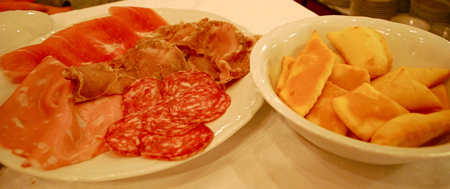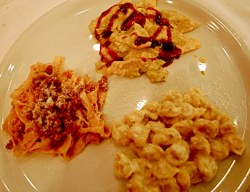Not for nothing is Bologna nicknamed La Grassa, or “the fat one.” The capital of Emilia-Romagna, arguably the gastronomic heart of Northern Italy, Bologna fills its kitchens with celebrated foods from around the region: balsamic vinegar from Modena, culatello from the Po Valley, and both Parmigiano Reggiano and prosciutto di Parma from the city that gave these renowned products their names.
A simple walk around Bologna’s
Quadrilatero district, the pedestrian heart of the old city, is enough to appreciate the centrality of food in Bolognese life—and, perhaps, appreciate a second sense of
La Grassa. While colorful produce displays spill onto the sidewalks, they are outshone by their more caloric neighbors: the dozens of fresh cheeses displayed at La Baita Formaggi; hand-twisted pumpkin
tortelloni in the window at
Tamburini; pendulous cured meats hanging down from
salumiera ceilings. This is not the Italy of tomatoes and olive oil.
A meal at
Trattoria La Braseria, not far from the Piazza Maggiore, serves as a memorable crash course in the culinary traditions of Bologna. A favorite of visiting notables from actor Roberto Benigni to soccer star Pippo Inzaghi—indeed, pictures and jerseys of Italian celebrities cover every wall—La Braseria is considered among the best destinations for classic Bolognese fare. And proudly living out this reputation, longtime operators Ivo and Simone show off their native cuisine with a heart-stopping parade of dishes. Piping hot
crescentini of fried dough appear with an array of local salumi: Bologna’s infamous mortadella; a soft, minimally salty prosciutto; unusually tender salami; and a subtly seasoned, delicate
coppa di testa.

House-made pastas follow a similarly carno-centric path. Hand-shaped tortellini alla Parma are filled with prosciutto, minced pork, mortadella, and parmesan cheese, scented with nutmeg and moscato and tossed in a further Parmesan-based cream sauce. Tagliatelle al ragú, the ancestor of America’s bastardized “spaghetti Bolognese,” is hardly touched with tomato, the light tangle of pasta supporting a sauce rich with pancetta and pork. And La Braseria’s fragile ravioli, drizzled with a red wine reduction, hide a filling of earthy mushroom and four cheeses.

Intrepid diners might continue with a veal cutlet, stewed rabbit, or grilled lamb—before moving on to the tableside trolley of dolci. But despite the caliber of each dish emerging from La Braseria’s kitchen, one might be tempted to stop with the primi. A first meal in Bologna is enough to begin to understand La Grassa—both the richness of its ingredients and the richness of its culinary tradition. And, perhaps, the richness of a culture that places such value in the sensory pleasures of food.